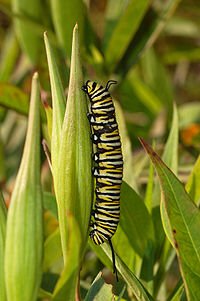
Photo from wikipedia
Abstract The conspecific negative density dependence hypothesis states that mortality of young trees (seedlings and saplings) is higher near conspecific adults due to mechanisms such as allelopathy, intraspecific competition, and… Click to show full abstract
Abstract The conspecific negative density dependence hypothesis states that mortality of young trees (seedlings and saplings) is higher near conspecific adults due to mechanisms such as allelopathy, intraspecific competition, and pest facilitation, explaining why in the tropics, most of plant species tend to be rare and live dispersed. However, there are some tree species that defy this expectation and grow in large clusters of conspecific juveniles and adults. We hypothesize that conspecifics living in clusters show higher and/or more variable defensive profiles than conspecifics with dispersed distributions. We evaluated our hypothesis by assessing the expression of physical leaf traits (thickness, and the resistance to punch, tear and shear) and leaf chemical defenses for six clustered and six non‐clustered tree species in Yasuní National Park, Ecuadorian Amazon. We ask ourselves whether (a) clustered species have leaves with higher physical resistance to damage and more chemical defenses variability than non‐clustered species; (b) saplings of clustered species may show higher physical resistance to damage and higher variation on chemical leaf defenses than their conspecific adults, and (c) saplings of non‐clustered species show lower resistance to physical damage and lower variation in chemical defenses compared to conspecific adults. Overall, our study did not support any of our hypotheses. Remarkably, we found that soluble metabolites were significantly species‐specific. Our study suggests that plants physical but not chemical leaf antiherbivore defenses may be a crucial strategy for explaining survivorship of clustered species. Trees in Yasuní may also fall along a suite of tolerance/escape/defense strategies based on limitations of each species physiological constraints for survival and establishment. We conclude that other mechanisms, such as those related to indirect defenses, soil nutrient exploitation efficiency, volatile organic compounds, delayed leaf‐greening, and seed dispersal mechanisms, shall be evaluated to understand conspecific coexistence in this forest.
Journal Title: Ecology and Evolution
Year Published: 2019
Link to full text (if available)
Share on Social Media: Sign Up to like & get
recommendations!